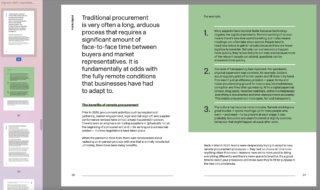
Traditional procurement is very often a long, arduous process that requires a significant amount of face-to-face time between buyers and market representatives. It is fundamentally at odds with the fully remote conditions that businesses have had to adapt to.
The benefits of remote procurement
Prior to 2020, procurement activities such as requirement gathering, market engagement, legal and risk sign-off, and supplier performance reviews have almost always happened in person. There’s been an emphasis on ‘calling suppliers in’ (physically ‘in’) at the beginning of a procurement and—for as long as business has existed—it’s how negotiations have taken place.
When the pandemic took hold, there was nervousness about replacing an in-person process with one that is entirely remote but ultimately, there have been many benefits.
For example:
1. Many aspects have become faster because technology negates the logistical problems. Remote working of course means there’s less time spent travelling, but it also means meetings can often take place sooner. People tend to need less notice to gather virtually because there are fewer logistics to consider. Not only can conversations happen more quickly, they’re less likely to run over, and because more of the relevant people can attend, questions can be answered more quickly.
2. The level of transparency has improved. Pre-pandemic, physical paperwork was common, for example, bidders would regularly print off tender packs and fill them in by hand. This wasn’t just an efficiency problem—paper forms and notes are a breeding ground for inaccuracy, incompleteness, corruption and they often go missing. With a digital papertrail (emails, blog posts, recorded webinars, online marketplaces) everything is documented and time-stamped more accurately. This makes procurement more open, fair and transparent.
3. The culture has become more inclusive. Remote working is a great leveller. It opens meetings up for more people who want—and need—to be present at each stage. It also probably dissuades any unprofessional or slightly coercive behaviour that might happen at a pub after work.
Back in March 2020, teams were desperately trying to adapt to new, remote procurement processes—they had no choice or time to do anything other than react. However, now we’re more used to doing everything differently and there’s more space to breathe, it’s a good time to revisit your processes and make sure they’re fit for purpose in the new circumstances.
How buyers should adapt to the new landscape
1. Update procurement policies
Update your procurement policies to reflect the new ways of working. Look at your current policy through a post-pandemic lens—are the processes and governance still fit for use? Paste the policy into a Google Document and invite anyone from your business area who uses your policy to highlight concerns, suggest improvements, flag which parts can be cut. Ask suppliers for their views—they are users of procurement services too. There will be easy fixes, for example, allowing more flexibility around how to attend meetings, but many procurement teams will also need to think about how procurement policy can be updated without breaking the law. It’s a fine balance.
2. Run market engagement differently
Buying digital services lends itself well to remote conversations with industry innovators during the market engagement period. Consider webinars and blogging as open and transparent ways to share your requirements and your thinking with supplier communities. Both are effective ways of encouraging two-way conversation with supply chains. Webinars in particular are a useful way of hearing suppliers’ ideas.
Make sure you allow potential suppliers to leave comments and questions in response to your blog posts and check your reply is public and visible to all. All communication will be digitally timestamped which helps minimise the risk of legal challenge.
3. Move towards a ‘minimum viable’ governance model
Traditionally, governance boards meet at cold, unfriendly headquarters. Often, senior officials are rolled out on 3 separate occasions: to approve the start of the procurement process; again to award the contract to the winning bidder, and a third time when the contract is signed. It’s heavy-handed and it does not need to be.
Start to encourage delegation by revising your organisation’s Delegations of Authority (DOAs). Involve senior people in the process to make sure they understand that when they give a colleague a DOA, they are handing over trust, responsibility and accountability, and that they should not then call those colleagues into a string of board approvals.
Suggest short, regular and informal catch ups for procurement people and senior stakeholders to talk about—even better, show—procurement products to colleagues. Show and tells are a good way to build trust and reassure the people who enjoy red tape situations. The more you do, the more you’ll show that light-touch governance isn’t about doing less, or about weaker risk management. It’s about opening up the process so there’s more chance of recognising problems early; it’s about trusting in the expertise of your colleagues and ultimately, it’s about making more effective use of time and public money.
Regulations must now catch up to new processes
Despite the pandemic forcing positive changes on everyday procurement processes, procurement regulations are slow to respond. This isn’t an easy task. Regulatory change needs chamber debate as well as royal or presidential assent, but this shouldn’t be a reason not to modernise. This means that competitive procurement activities still take far too long—often months instead of weeks. I hope this is the catalyst to update some of the regulations such as reducing the minimum required days a tender should be put out for.
I’ve championed the use of technology and a move towards working in ways more aligned with digital delivery teams long before the pandemic set in. I’m hopeful those involved in procurement processes can use this as an opportunity to do things more efficiently. It’s time we dragged dated procurement practices into the internet era.